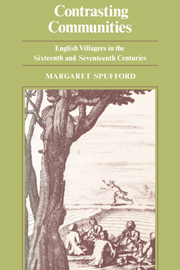Book contents
- Frontmatter
- Contents
- List of maps and graphs
- List of tables
- List of abbreviations
- Acknowledgements
- Dedication
- Introduction
- Map 1 Cambridgeshire: natural boundaries and soil types
- Map 2 Cambridgeshire: county and parish boundaries
- PART 1 People, Families and Land
- 1 The peopling of a county
- 2 The problem: the disappearance of the small landowner
- 3 The reality: the small landholder on the chalk: Chippenham
- 4 The reality: the small landholder on the clay: Orwell
- 5 The reality: the small landholder in the fens: Willingham
- General Conclusions to Part One
- PART 2 The Schooling of the Peasantry
- PART 3 Parishioners and their Religion
- Conclusion
- Appendix 1 The Butlers of Orwell
- Appendix 2 Notes on Graphs 3 and 5
- Index of Contemporary Names
- General Index
General Conclusions to Part One
Published online by Cambridge University Press: 25 January 2010
- Frontmatter
- Contents
- List of maps and graphs
- List of tables
- List of abbreviations
- Acknowledgements
- Dedication
- Introduction
- Map 1 Cambridgeshire: natural boundaries and soil types
- Map 2 Cambridgeshire: county and parish boundaries
- PART 1 People, Families and Land
- 1 The peopling of a county
- 2 The problem: the disappearance of the small landowner
- 3 The reality: the small landholder on the chalk: Chippenham
- 4 The reality: the small landholder on the clay: Orwell
- 5 The reality: the small landholder in the fens: Willingham
- General Conclusions to Part One
- PART 2 The Schooling of the Peasantry
- PART 3 Parishioners and their Religion
- Conclusion
- Appendix 1 The Butlers of Orwell
- Appendix 2 Notes on Graphs 3 and 5
- Index of Contemporary Names
- General Index
Summary
In a fen parish the resources of stock farming and dairying made it economically feasible for small holdings to survive. Therefore, when manorial control slackened in the seventeenth century, conventional medieval tenements which had maintained their integrity for centuries fragmented and there was a great increase in the number of tenants with small, but viable, holdings of between two and sixteen acres.
The arable acreage was not in any case important here; nor was it comparable with those in the uplands. The tenant of a half-yardland of fifteen acres of meadow and marsh, was, in Willingham, a wealthy yeoman. It was not the acreage of arable but the possession of fencommons and the stock which went with them, which mattered. The existence of the fens and their grazing rights meant that bequests of fragments of land to younger sons here seem often to have established a new family in the village. Similar bequests which were made to younger sons in Orwell and Chippenham by fathers who nominally also practised impartible inheritance could not usually establish a family. In the fens younger sons could remain and still make a living from their fragments of land, without weakening the main holding, as elsewhere, below a point at which it was no longer a viable unit. In addition, the influx of people from outside who had been displaced elsewhere was probably greater than the small number of men who left such villages.
- Type
- Chapter
- Information
- Contrasting CommunitiesEnglish Villages in the Sixteenth and Seventeenth Centuries, pp. 165 - 168Publisher: Cambridge University PressPrint publication year: 1974



